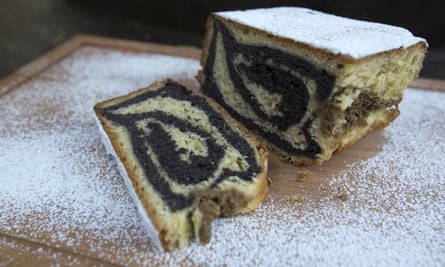My grandmother loved baking and was, therefore, an excellent baker. I can still see her massaging flour, sugar, eggs, yeast, butter and milk into dough and injecting the pastry with apricot jam to make buhteljni. I remember devouring her apple pies, pear pies, blueberry strudels, half-moon-shaped vanilla biscuits called kifeljčki, quark rolls generously topped with cream, and fried yoghurt pastries, known as miške (little mice), while always wanting more. I can still hear her saying that to her, a sustainable farmer, baking was the closest she could get to “the world of art”. I regret never telling her that even though she wasn’t graced with the life of an artist, she was nonetheless weaving something larger than her: a culture.
Maybe she understood what she was doing after all. Once, she instructed me to never follow her recipes, but instead to adapt them however I saw fit. A culture, she was essentially saying, should be modified in line with the tastes and needs of the times.
Well. I have altered most of my grandmother’s recipes, apart from the one – her recipe for potica, a traditional Slovenian pastry usually served at holiday, birthday and special celebrations. In essence, it is a roll made of leavened paper-thin dough, most often stuffed with walnut filling and raisins, blanketed with powdered sugar. It has to be snow white.

Calling potica a “filled roll”, makes it seem easy to prepare, but it requires hours of work – preferably by more than one pair of hands. The most excruciating part is crushing the walnut shells and then grinding the walnuts. Before my grandmother began using a grinder, we filled a bag with, say, 100g of walnuts and beat the bag with a hammer, until the nuts – and our wrists – turned to paste.
Ah, but why not simply buy a kilo of ground Californian walnuts? Oh! Because the secret to the best potica known to humans is walnuts from a tree that grows on my grandmother’s farm. This lush, 15m-tall individual is an amusement park for crows and insects, and is also often populated by naively courageous children. It bears the crunchiest, sweetest walnuts – yes, walnuts can taste honeyed – which smell of early autumn, even in a potica made in the darkest of winters.
Was, bore, smelled, I should write. In the past decade, the 30-year-old tree has changed. At first, the romantic in me wanted to believe it was mourning my grandmother’s – its primary carer’s – death and just couldn’t yield sweet nuts any more. It could only give us bitter ones. Next, I resorted to common sense. Walnut harvests, I told myself, differ from season to season, so our half-empty baskets are nothing to worry about. However, after the fifth poor harvest with dry, astringent fruit, I understood that I was witnessing something else entirely. A metamorphosis better known as decay.
In suitable conditions – mild weather, low temperature fluctuations, low humidity – walnut trees in our region can live up to 100 years and yield nuts until they’re middle-aged. But the circumstances for that particular potica tree and, by extension, its kin, have worsened. The trees endure spring frost and snow. Winds resembling tornadoes. Storms and floods. Heavily polluted air, water, soil. Fires. Summers you might expect in the tropics – with parasitic fungi one would think only existed in such climates. The walnut tree in my grandmother’s front garden endured this beating, bending to it, for more than 10 years. Today, I – a hardened realist – am not even remotely surprised that it just had to break.

My potica projects may, less tragically, expire as well. Since I can’t make a proper walnut roll any more, I decided to finally adapt the recipe. I bought a couple of packages of almonds, from California, of course, but when I saw them sitting on the kitchen counter, I thought nope, I am not doing this. Those 500g went straight into my morning porridge, where they can’t damage my grandmother’s legacy. Even though she instructed me to modify recipes, she couldn’t have meant for me to succumb to a culture that, after an initial sweep of exploitation, always finds consumption alternatives. She couldn’t have meant that, because hers was a culture of safeguarding the lives of that potica tree and all its various kin, of bees, of cats and cows and birds and granddaughters. Hers was a culture of safeguarding life.
after newsletter promotion
Well. I spotted a glimmer of hope for poticas early this year. A sapling next to the dying tree. It survived a summer of catastrophic floods with heatwaves on the one hand, and suspiciously low temperatures on the other. Perhaps the dying tree delivered all its remaining nutrients to this sapling, whispering: “The preservationists are already here, trust me. Some of them are hardened realists, others are dreamy romantics.”
-
Ana Schnabl is a Slovenian novelist, editor and critic
